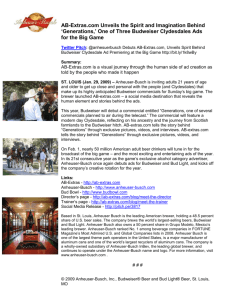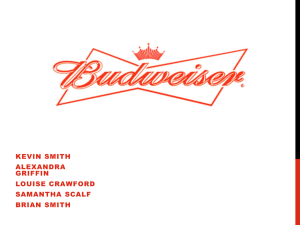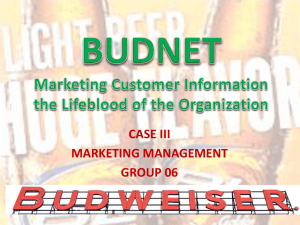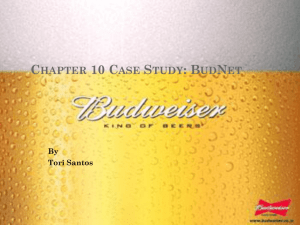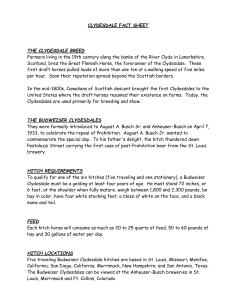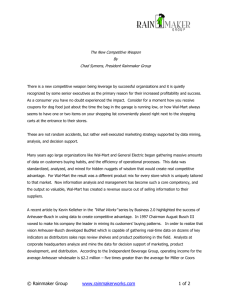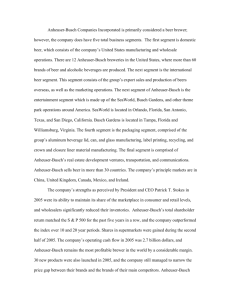Supply Chain Company Project (Budweiser)
advertisement
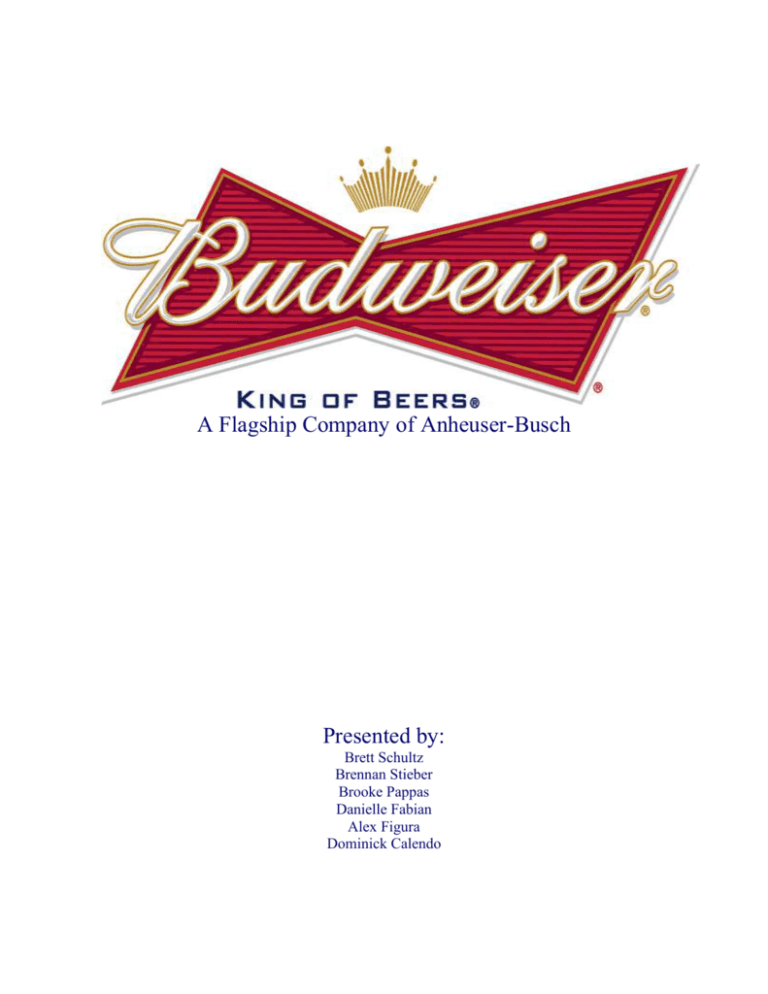
A Flagship Company of Anheuser-Busch Presented by: Brett Schultz Brennan Stieber Brooke Pappas Danielle Fabian Alex Figura Dominick Calendo Table of Contents I. Executive Summary II. Introduction III. Budweiser’s Procurement Strategy IV. Manufacturing Concepts V. Transportation System & Third Party Logistics VI. Warehouse Systems VII. Sustainability Efforts VIII. Surprises found IX. Appendix X. Reference Page I. Executive Summary Anheuser-Busch Company founded Budweiser in 1876. Anheuser-Busch has 12 breweries in the United States, and sells beer in 80 countries, with top distributors in 25 countries. Budweiser is known as the “King of Beers” and accounts for 4.4 percent of the global beer market. While conducting research on Budweiser’s purchasing strategies, we came to the conclusion that Budweiser’s ERP system is essential in establishing customer loyalty. Also, we discovered that Budweiser could run into some cross-cultural issues when negotiating with foreign suppliers and distributors. The information provided by Anheuser-Busch on the manufacturing process, explains the seven steps in creating the perfect Budweiser. The five main ingredients that make Budweiser’s memorable taste are rice, hops, malt, yeast and water. Anheuser-Busch uses both rail and truck in their transportation system. The large volumes of inbound ingredients are mainly transported via railroads. While truck is used to move a portion of raw materials. Two groups manage Anheuser-Busch's transportation needs, Corporate Transportation and Operations Services Transportations. They both are in charge of multiple different responsibilities. The carrier selection process is an extensive procedure where carriers must meet all requirements necessary. AnheuserBusch also uses third party logistics companies, two of them being: Coyote Logistics and CH Robinson. Anheuser-Busch has done a great deal to give back to the community, plant, and economy. Sustainability is a top-level priority at Anheuser-Busch with a focus on people, environment, and recycling. II. Introduction Nearly a century and a half old, Anheuser-Busch Company, Inc. is currently the leading American brewer, holding a 47.6 percent share of U.S. beer sales to retailers. Anheuser-Busch first introduced its flagship company Budweiser in 1876, when the company founder Adolphus Busch, set out to create the United Sates first truly national beer brand. Budweiser sells in a business-to-business industry. Anheuser-Busch takes pride in only selecting the finest ingredients to brew and package its beers in their 12 breweries throughout the United States. Anheuser-Busch established international operations in 1981, which has built a significant presence in foreign markets, selling beer in 80 countries worldwide, and partnering with top brewers and distributors in 25 countries. Budweiser is the world’s best-selling beer, accounting for 4.4 percent of the global beer market. Today, Anheuser-Busch brews approximately 30 beers in the United States, which are broken down into several categories: the Budweiser family, the Michelob family, specialty beers, non-alcoholic brews, the Busch family, the Natural family, malt liquors, special malt beverages, and alliance partner products. Of all the beers, Budweiser, “The King of Beers,” leads the U.S. Premium beer category and outsells all other domestic premium beers combined. The Budweiser Family currently consists of Budweiser, Budweiser Select, Select 55, and Budweiser & Calmato Chelada. Budweiser Select was introduced in 2005 as a hybrid premium regular/ premium light beer containing only 99 calories and 3.1 grams of carbohydrates. Select 55 was introduced in 2009, as the lightest beer in the world, with 55 calories and 1.9 carbohydrates. Budweiser & Clamato Chelada was introduced in 2008 and is a combination of Budweiser and Bud Light with a refreshing taste of Clamato spices and a hint of lime. III. Budweiser’s Procurement Strategies Budweiser is a globally known market with an abundance of procurement strategies. The first focus is on the important supplier relationships established with Budweiser and other companies. Anheuser-Busch is the proud owner of all Budweiser products around the world. The most prominent form of Budweiser products are bottles, aluminum, and recycled aluminum. In conducting our interview with Dan Schultz, we found that Budweiser’s suppliers consist of all liquor stores, grocery stores, and convenient stores. The largest buyers consist of 80% liquor stores, convenient, and major chain stores across the globe. The remaining 20% is composed of restaurant bars and venues. It’s also important to realize that Budweiser has buyers in many arenas and stadiums across the country. The competition is quite competitive between Miller and Coors being their two biggest competitors. Products like Budweiser Select and regular Bud Light stem from the production of Anheuser Busch as well. This leads right into Budweiser’s degree of outsourcing. Budweiser’s main focus is on the United States market. However, with that being said Anheuser-Busch licensed their right to market Budweiser and brew it to places like Labatt in Canada, Modelo in Mexico, and Kirin in Japan, rather than buy a foreign company or build breweries of its own in other countries. According to the Coopers & Lybrand (1997) study “50 percent of firms involved in alliances market their goods and services internationally versus 30 percent of no allied participants.” This fact just shows how essential international marketing can be to a market firm and how much productivity and recognition can increase. Another key aspect when outsourcing is the possibility of counterfeiting when trade is made from one country to another. According to an article pertaining to suppliers in China, “Anheuser–Busch, was confronted with several counterfeit Budweiser beer products in China, they now have taken the initiative of using imported foil for its packaging in China which is difficult for counterfeiters to obtain. The foil changes to red when the weather becomes cold.” Budweiser being involved in the global market, has distributors that must purchase beer from producers or other distributors and sell them to a number of wholesalers. In China, Budweiser's distributors include: Qinhuangdao – Lianda, Jinshida, and Haoshen in Shanghai. These distributors deal with maintenance issues while delivering their Budweiser products to different suppliers within their area. This type of maintenance and repair does not only occur in China, but in the United States as well. The lead time and the order size of each order depends on the indirect costs associated with the delivery of the manufactured items. Factors that come into play are: fuel charges, driver wages, porter wages, and road maintenance fees. All of these expenses can have a big part in the successful delivery of Budweiser products to their distributors, and suppliers. One type of information technology that Budweiser uses is online advertising. Social media plays an enormous role in advertising of industries in today’s society. Facebook and Twitter can promote so many different products and Budweiser has reached out and made them known. The most important ERP system used by Budweiser is Anheuser-Busch’s website, which establishes nearly 40 million dollars in revenue. The information technology used by Budweiser is referred to as AB Mobility. The “I Dig” creates different sales reports and performance reviews. The “T-Com” unit is responsible for the transmission of orders. This website is a chance for Budweiser to enhance their global financial accuracy and commercial agreements. Also, two big advantages of this website are to increase maintenance efficiency and compliance accuracy. Overall the basic purchasing strategy of Budweiser products can be described in many different ways. However the same goal of a successful product and a profitable company applies to all. The most impressive part about this ERP system is the objective to increase sales by rewarding customer loyalty. Budweiser can really establish a whole new level with this new information technology. IV. Manufacturing Concepts Budweiser has a simple strategy when it comes to their manufacturing concept. There are five main simple ingredients put into Budweiser that creates its fresh taste. The beer is made from rice, hops, malt, yeast, and water. The rice was added to the brew to establish a different taste among other lagers. The hops are hand selected by Budweiser’s brew masters from the world’s best locations in the Pacific Northwest and Europe. AnheuserBusch also has their own hop farms located in Bonners Ferry, Idaho, and Hallertau, a region in Germany. The malt is known as the “Soul of the beer” according to the brew masters. Soaking the barley kernels in water, germinating the seeds, and drying them in a kiln make the malt. The barley experts of Anheuser-Busch have visited more then 2,000 barley fields, which are primarily found in Montana and Idaho. The yeast is directly from the original recipe, and is often under estimated in the flavor it gives to the beer. Finally the water goes through a multi-stage filtration process to assure purity. The brew masters taste almost as much water as they do finished beer to assure the freshest product. In 1876, Adolphus Busch put these ingredients together and created the taste of the American style lager we love today. There are seven steps to the brewing process of Budweiser. The first step of the process is milling. Milling is simply grounding the barley, malt and rice, and making sure that it is precisely weighed out. The next step of the process is mashing. Mashing occurs when the barley, malt, and rice are mixed with water. The natural malt then breaks down the starch from the grains into fermentable sugars. The third step of the process is straining. Straining is when the combined grain mash from the step before is strained, which leaves a sugar amber liquid called wort. The forth step of the process is the Brew kettle stage. In the Brew kettle stage the hops are added to the boiling wort in the brew kettles to add that spicy taste in the beer. The fifth stage of the process is called Primary Fermentation. In this stage the wort is cooled, and then the yeast is added. For six days, the yeast ferments the wort into beer. The sixth step of the process is most important for creating the perfect Budweiser. Beechwood Aging is a process when the beer is naturally carbonated and aged on beechwood chips for 21 days to mature the flavor of the beer. The Anheuser- Busch Corporation is the only major brewer in the world to use the beechwood aging process. The final stage of the process is the finishing stage. During this stage, brewers remove yeast and unstable protein materials from the beer. The beer is then chill proofed and filtered before being packaged to put on the shelves. However, before the product is put on the shelves for customers to purchase, each batch of Budweiser is tasted by the brew masters at least five times during its life at the brewery. They also make sure to check all the raw materials in the product, taste the samples from various stages of the brewing process, and compare the packaged beer between batches to ensure consistency. Each batch of Budweiser follows this same family recipe used by five generations of Busch family brew masters. The family recipe is practiced in twelve different locations throughout the United States. V. Transportation System & Third Party Logistics Anheuser-Busch uses both railroad and truck depending on the quantity that is being moved. Because of the large volumes involved, most of Anheuser-Busch’s inbound ingredients move via railroads. Conversely, a portion of raw materials moves via truck, in bulk pneumatic trailers. Truck is certainly a main mode of transportation, but rail is also used on a lot of the cross-country moves (Gilbert, 2013). All the trucks from the brewery to the wholesaler are other carrier companies’ assets. For example, the bud light trucks on the road are their dedicated carriers who are forced to get their trailers wrapped in Anheuser-Busch branding in order to be considered their dedicated fleet. Carriers that are approved to haul beer for Anheuser-Bush use either refers (refrigerated) or dry vans (nonrefrigerated) as the equipment. These carriers are selected through an annual bidding process. Budweiser is mainly delivered to other breweries, distribution centers, and wholesalers, with the largest percentage going to wholesalers, about 90 percent or so. Two different groups with separate responsibilities manage Anheuser-Busch, Inc. transportation needs. The first group is Corporate Transportation, they are in charge of: carrier selection, carrier planning, administration (claims, legal, etc.), and negotiations (contracts, and published rates). All carriers utilized by Anheuser-Busch are reviewed by Corporate Transportation for their service history, equipment appearance and quality, pricing competitiveness, past safety record, insurance coverage, and compliance with transportation regulations. The majority of inbound materials are purchased on a delivered basis. Corporate Transportation may provide leads for these backhauls, but the main responsibility remains with the carrier. The second group is Operations Services Transportation. They are responsible for carrier performance, carrier scheduling, and Brewery Operative Contact. Only twelve breweries supply the demand for the world’s finest beers. Because of this, the partnership between Anheuser-Busch and its carriers is essential for efficient product distribution. Anheuser-Busch wholesalers are responsible for about 65 percent of the outbound beer shipments. This is mostly done in their own trucks or with contract carriers. The rest of the outbound beer shipment volume is controlled by Anheuser-Busch and shipped by rail or a common carrier. Anheuser-Busch also uses JDA Transportation for their European Logistics. Based in Leuven, Belgium, Anheuser-Busch InBev manages well over 200 beer brands that include their global flagship brand Budweiser, which represents about a tenth of global volume at AB InBev. Anheuser-Busch InBev launched Budweiser last August in Brazil, where the company already enjoys about a 70% market share on the back of major local brands (Esterl, 2012). The successful executions that JDA Transportation solutions has done in Anheuser-Busch’s Argentina, Brazil, Russia and U.S. operations, this has led to greater efficiencies, improved customer service, and reduced the company’s carbon footprint. Executives say initial sales of Budweiser, which is being marketed as a more premium product abroad, are going well in South America's biggest market (Esterl, 2012). This is when Anheuser-Busch decided to roll out the solutions to its Benelux, Germany and United Kingdom operations as well. Anheuser-Busch is extremely quality/product freshness conscious. Therefore, when there are conditions of extreme heat or cold, protective service is required on all draught beer. Their products must be handled with extreme care and caution to avoid can abrasion, which if happens, makes the product unsalable. The density of shipments causes the trailers to reach maximum weight before they reach maximum capacity. One main goal of Anheuser-Busch is developing long-term relationships with their carriers. Carriers selected by Anheuser-Busch must guarantee on-time pick up and delivery. They must also offer and dedicate clean, well-maintained equipment. Anheuser-Busch went about a re-engineering effort called “Transportation Advantage.” This involved review and re-configuration of their long-haul and short-haul delivery system of beer to wholesalers. The main objective of this was to lower costs and improve service by controlling the buying power for all brewery inbound and outbound transportation, including both truck and rail (Willis). The results of applying this have been astonishing. In Brewery Operations, transportation costs have been reduced by 15 percent. In wholesaler and Support Center Operations, transportation service is 99 percent on-time or early and wholesaler out of stocks have decreased by 30 percent. Two third party logistics companies that Budweiser uses is, Coyote Logistics and C.H. Robinson. The beer is made from rice, barley, malt, and yeast and some are made with corn. The corn is mainly from the mid west region. According to Dan Schultz, “Budweiser suppliers reach from mid west farmers in America to over seas. The rice supply comes from China and Gops (a seed by product from leaves) comes from European countries. There is no animal by products in Budweiser ingredients witch makes bud a vegan product.” Another source, Zach Gilbert, manager of Budweiser’s freight at 3PL company Coyote Logistics stated, “The packaging that Budweiser uses is cases that are shrink wrapped on pallets. One special requirement they have is that kegs must be delivered within fourteen hours or refrigerated at 38 degrees.” VI. Warehouse Systems The warehousing concept is a huge component for many companies, especially when dealing with logistics and supply chain management. Budweiser is Americas’ best selling beer selling close to fifty percent of all beer sold in the U.S. After analyzing the interview we conducted, with Dan Schultz, we learned a lot more about Budweiser’s specific warehousing processes. The warehousing system that Budweiser uses is called C.E.W. Temperature Points for Inventory. Budweiser does have a value added service of doing its own merchandising that helps add to its success. They do everything from setting up the companies displays to offering incentives to buyers who buy in bulk. Budweiser’s special advertising with different companies and other products brings value. Simple examples are: buying a case of Budweiser and getting free chips or buy one case of water for a penny. Others include free give a ways like food. Food tends to help compliment beer and add value to the customer. Budweiser uses several methods of technology. The main source they use is AM Mobility and the “I-Dig”. The I-Dig creates different sales reports for the each different performance of retailers. “T-Com” is a unit that is used to transmit orders. Counts from inventory are taken on daily basis and reports are given to the brewery to fill scheduled shipments to distributors. One online article interviewed, Tom Sarette, the San Antonio, Texas general sales manager. He said there were approximately 900 thousand cases in the warehouse. That amount of beer was just three weeks of inventory. That is only one of the many warehousing sites of Budweiser Company. Budweiser also needs to store its inventory in certain controlled climates. All the warehousing sites must be sure to accommodate that factor. According to the Anheuser-Busch Official Website, beer can spoil and begin to taste bad when it ages. Budweiser being aware of this uses the first in first out method also referred to as FIFO. They set a specific number of days for cans and kegs to sit in inventory limiting the shelve life. That is one huge inventory strategy Budweiser sticks to know matter which location of warehouse its products are at. Budweiser uses a centralized warehousing system making it affordable to send shipments to other facilities and shipping distribution sites. VIII. Sustainability Efforts Sustainability is an extremely important concept for those at Anheuser-Busch. Anheuser has set forth crucial goals to better our environment, community, and social responsibility. Anheuser-Busch has a responsibility to our community most other companies do not. That responsibility is alcohol responsibility. Since 1982, AnheuserBusch and their wholesalers have contributed more than $908 million in advertisement campaigns to prevent underage drinking and drunk driving. Anheuser feels it is their responsibility to see that that their product is not misused. Good Sport is a management program constructed by Anheuser to help stadium owners and concessionaires create positive crowd behavior by promoting responsible drinking. However, not all Anheuser- Busch products are consumed at sporting events and concerts. Consumers’ host parties were it is the responsibility of the host to make sure guests drink responsibly. That is why Anheuser created the Bud Light Party Code, a list of tips and tricks for hosts to make sure their guests drink responsibly and get home safely. Aside from Anheuser-Busch’s product specific alcohol responsibility, the corporation must still adhere to normal sustainability measures. Anheuser-Busch is determined to improve its environmental performance. Their environmental efforts focus on three specific issues: water, energy, and recycling. Since 2007 Anheuser-Busch has reduced its overall water usage by 40%. Anheuser Busch’s brewery in Cartersville, GA is the most water-efficient brewery in the entire global company, sporting a water use metric of 3.04 hectoliters per hectoliter of production. To reach the level of energy efficiency Anheuser-Busch demands the corporation joined The U.S. Environmental Protection Agency’s Climate Leaders program in 2005, and took a vow to reduce greenhouse gas emissions from 2005 levels by 5% by 2010. The Anheuser-Busch recycling Corporation established in 1979 has paved the way for Anheuser-Busch to accomplish the feat of recycling 99% of the solid waste produced by the brewing and packaging process. Anheuser-Busch has accomplished a great deal in the fields of alcohol and environmental sustainability. However, its most impressive goals are met in the final field of sustainability, community. Since 1997, Anheuser Busch has donated over $515 million to organizations that support education, economic development, disaster relief, and military personnel. This number does not include the hours volunteered by Anheuser employees toward charitable organizations. Employees of Anheuser-Busch volunteered their Saturdays to help build a deserving St. Louis family home. Anheuser donated $50,000 to the project. Additionally, 250 Anheuser employees volunteered their time to The New Orleans Habitat for Humanity Organization to help clean up neighborhoods and build homes; Anheuser donated another $50,000 to this project. Between the years of 2011 and 2012 Anheuser donated a total of 3.2 million cans of water to help in disaster relief from storms, floods, earthquakes, and other natural disasters. The map below details Anheuser-Busch's distribution of water to those in need in 2011/2012.
